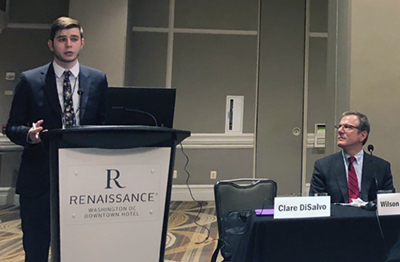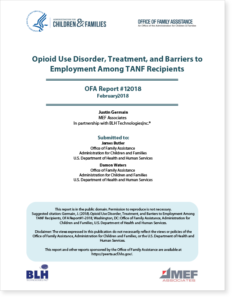Addressing the Research Gap
As the opioid epidemic has proliferated rapidly throughout the United States over recent years, many state TANF programs have questioned how best to adapt their services for families experiencing the effects of opioid use disorder. Despite emerging research about the epidemic in general, states have lacked research focused on the epidemic’s effect on TANF recipients, specifically.

In 2017, the Office of Family Assistance (OFA) asked MEF to fill that gap by collating available research relevant for the TANF population and quickly sharing it with practitioners in the field.
As a first step, MEF’s Justin Germain developed a white paper surveying available prevalence rates, current service provision strategies, and promising practices for TANF programs. Given the lack of research in the area, MEF widened the research scope to draw on available research from similar domains, MEF expanded the research scope to focus on approaches for other low-income populations experiencing opioid use disorder as well as general substance abuse among TANF recipients.

Rapidly Disseminating Findings
To maximize accessibility and learning options for practitioners, MEF co-facilitated a webinar along with other opioid use experts to share the paper’s findings and highlight the Kentucky Targeted Assessment Program (TAP) and Vermont’s Children and Recovering Mothers (CHARM) Collaborative, two promising programs serving TANF-eligible individuals. In addition to the webinar, OPRE’s 2018 Research and Evaluation Conference on Self-Sufficiency (RECS) provided another opportunity to share this timely research to practitioners and policy researchers alike.
Watch the Full Webinar
Discussions and Questions from the Field
Together, these practitioner-tailored activities sparked much-needed discussion about strategies and next steps for human services programs. Webinar and RECS attendees discussed the interplay between employment services and treatment options, including strategies to engage TANF participants in treatment options and how proposed Medicaid work requirements might affect treatment options. Attendees also discussed the need for relevant training programs for frontline staff.

To see what answers Justin and his fellow panelists provided, check out the Questions and Answers collated by OFA Peer TA.
While the opioid epidemic remains a pressing issue for all human service programs, practitioner-ready research and peer-to-peer learning opportunities can inform local decisions to improve services for families affected by opioid use.
